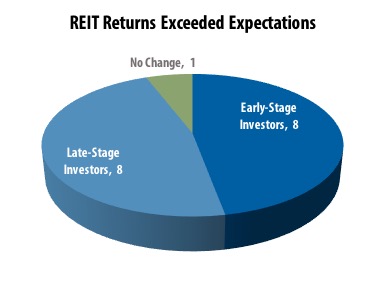Investment Timing and Performance in Full-Cycle Nontraded REITs
Many investment professionals assume that it is better to invest in nontraded REITS later in their fundraising period rather than earlier. The recent study of full-cycle events by nontraded REITs performed by Blue Vault and The University of Texas at Austin McCombs School of Business, casts doubt on that assumption.
In fact, many investors, advisors, and REIT sponsors might be surprised to learn that for those 17 nontraded REITS that  have gone full-cycle since 1990, the average annual returns of early-stage investors exceeded those of late-stage investors in eight REITs, late-stage investors outperformed early-stage investors in eight REITs, and one REIT showed no differences in returns between early- and late- stage investors.
have gone full-cycle since 1990, the average annual returns of early-stage investors exceeded those of late-stage investors in eight REITs, late-stage investors outperformed early-stage investors in eight REITs, and one REIT showed no differences in returns between early- and late- stage investors.
From the results of this study, we have identified four key factors that influence how the timing of an initial investment can make a difference in an investor’s average rate of return. They are:
1. The REIT offers early investors a discounted share price.
2. The REIT achieves higher-than-average capital gains.
3. The REIT achieves capital gains rather than capital losses.
4. The REIT offers higher-than-average distribution yields.
Discounted Share Price
Perhaps the most obvious explanation for higher average returns enjoyed by early investors is a discount offered during the early stages of the capital raise. Of the 17 nontraded REITs in the study, five offered discounts of roughly 5% for early-stage investors (e.g. shares at $9.50 versus $10.00 for later investors). For four of these REITs, the average returns of early investors exceeded those of late-stage investors by +3.13% to +0.53% with only one REIT showing no difference.
Above-Average Capital Gains
A second factor explaining differences in average returns would be the size of capital gains achieved. A nontraded REIT that provides significant capital gains at the full-cycle event will tend to reward late-stage investors with a higher average rate of return because those investors have the same capital gain as the early investors, but it is averaged over a shorter time span. For example, one of the REITs in the study provided investors with a 23.5% capital gain at its full-cycle event. The REIT’s last investors held the REIT shares for 11 fewer quarters (15 vs. 4) than the earliest investors, giving them a 13.4% higher average rate of return over their holding periods. While this is the most extreme example, five of seven REITs with above-median capital gains rewarded late investors with higher returns, and only three of nine REITs with below-median capital gains did so.
Capital Gains Versus Capital Losses
A third related factor determining differences between average returns for later versus earlier investors is just another way of looking at capital gains and losses. Of the 13 REITs that had capital gains, eight provided higher average total rates of return to later investors. For those three that experienced a capital loss, none provided higher returns to later investors. The same logic applies as with the size of capital gains: gains averaged over fewer periods provide higher average rates of return. Capital losses averaged over fewer periods imply lower average total rates of return when combined with distribution yields.
Higher Distribution Yields
There is a fourth factor that appears to influence differences in average returns between late- and early-stage investors. Nontraded REITs with average distribution yields that exceeded the sample median (7.79%) were more likely to provide early investors with higher average rates of return than late investors. Five of the seven REITs with distribution yields above the sample median gave early investors higher average rates of return than later investors, while seven of 10 nontraded REITs with yields at or below that median distribution rate had lower average rates of return for early investors. When a nontraded REIT offered distribution yields above the median, investors did better by getting in earlier.
One factor which we might suspect could influence differences in average returns between early and later investors would be the time lag between the two investments. The bad news here is that investors may not know how long the capital-raising period may last, as many nontraded REITs extended their capital raise beyond the initial 24-month period (some for as long as six additional years). The good news is that apparently the length of time between the earliest investments and the latest didn’t make a significant difference in average returns across the sample. Both those REITs in the sample with the shortest fundraising periods and the longest fundraising periods were equally likely to underperform the group’s average return as to outperform. That is, even if investors knew how long the REIT would be raising funds, that information wasn’t necessarily of value in forecasting higher returns.
In summary, the timing of investments in nontraded REIT programs may influence average rates of return but, interestingly, only two of the factors we have identified are observable at the time the investment decision is made (share price discounts and above-median distribution yields). Both of those factors when observed with the 17 REITs in the full-cycle event study have appeared to favor early investors.
Investment_Timing_and_Performance_in_Full-Cycle_Nontraded_REITs_WEB












